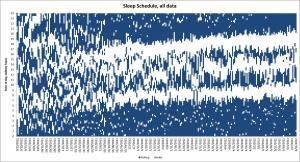 Here at the Baby Sleep Site, we’re not short on sleep-related facts and figures. Nicole, a self-proclaimed “numbers nerd” can offer our clients all the sleep-related data their hearts could desire! Not all of us are as number-nerdy as Nicole, of course, but sometimes, having data helps us understand our babies’ sleep issues, and even helps us come up with solutions to the problems.
Here at the Baby Sleep Site, we’re not short on sleep-related facts and figures. Nicole, a self-proclaimed “numbers nerd” can offer our clients all the sleep-related data their hearts could desire! Not all of us are as number-nerdy as Nicole, of course, but sometimes, having data helps us understand our babies’ sleep issues, and even helps us come up with solutions to the problems.
Recently, Baby Sleep Site reader Beth e-mailed us some information about her own son’s sleep development. Turns out Beth (a Ph.D. Pharmacologist, Neuroscientist, and numbers nerd extraordinaire) had been using an app* to track her son’s sleep patterns from the time he was three weeks old up until now (at 9 months). And she didn’t just track sleep. She tracked feedings, diapers, medications, etc. As she put it:
“…the app meant the information was always with me for appointments, etc. And if there is one thing I’ve learned, the minute you think you can stop tracking things, the baby gets constipated or some such, the doc asks when was the last bowel movement, and you just don’t know. So, the app means I can log it in and it’s easy peasey!”
Beth says the process of actually tracking her son’s sleeping patterns was very straightforward and easy:
“I ‘check in’ the baby when he falls asleep and ‘check out’ the baby when he wakes up. For me, it has been most useful on the day to day basis so I can easily answer my questions, like, “When, exactly, did he go down for that nap?”, “Was that another 45 minute naplet?” and “Is he really short on sleep today?” For that, the app has been fantastic.”
Along the way, Beth turned her long list of data into a set of graphs, making it easier to see and interpret her son’s sleep patterns. The result of Beth’s work? An incredibly comprehensive, detailed account of how sleep develops in a baby from birth – 9 months! And because we love our readers so much, we want to share this awesome information with you. We know you’ll benefit from it.
Okay. Enough background information. On to the graphs!
Graph #1: Wake and Sleep Times

*Click graph to view a larger version in a new browser window.
This graph tracks the timing of Beth’s baby’s sleep. This includes when he wakes in the morning, when he goes down for his first and second nap, and when he goes to bed. The numbers on the left indicate the time of day (in military hours). The dates along the bottom go week by week, from the time the baby is about 4 months old until recently, when he was 9 months. The red lines on the chart are what we want to focus on. They help us see the “average” for sleep and wake times.
What’s most interesting about this chart, in my opinion, is how much the morning wake times and first nap times correspond to each other. You’ll notice that they move together. When the baby wakes later in the morning, the first nap starts later. Bedtime also follows a smooth pattern, becoming gradually later as the baby gets older.
Even more interesting? The afternoon naps don’t correspond at all, to anything! They’re all over the place. This illustrates what Nicole often tells our clients about babies’ naps and schedules. The morning nap is the most important and the most restorative, while the afternoon nap can vary. If you have an errand to run or a trip to plan, try to do it after the baby’s first nap, if he has more than one.
Nicole’s Note
“The morning nap is the first to establish. It usually, but not always, becomes the most predictable and the easiest to get. The second nap, while some babies sleep better based on the clock, others sleep better based on how long they’ve been awake. Still others will even change their nap time based on how active or busy their morning has been. The interesting thing about this chart is you can see bedtime getting later as baby is getting older. You can see how wildly variable the schedule is when the baby is younger and it becomes more regular as he gets older. This shows that it does get better!”
Graph #2: Sleep Amounts and Duration

*Click graph to view a larger version in a new browser window.
This graph is identical in its set-up to the previous graph, but this one charts the length of Beth’s baby’s naps and nighttime sleep, instead of tracking the time of day the sleep happened. The numbers along the left and right sides (the number on the right are for nap #2) represent total hours. You can look at each of the red lines to see averages for how long the baby’s morning naps, afternoon naps, and nighttime periods of sleep were.
The take-away from this chart, I think, is the simple fact that a baby’s sleep is a fluctuating thing. This chart illustrates a frustrating phenomenon that I think all of us parents have experienced. A baby who sleeps 10 straight hours one night (or takes 3 beautiful naps one day) is cranky and waking constantly the next. Just when we think, “They’ve got it!” our babies prove us wrong.
Something else I saw… Notice how the morning and afternoon nap lines tend to mirror each other. When the morning nap line dips, the afternoon line spikes, and vice versa. This seems to show that when the baby had a shorter morning nap, he made up for it in the afternoon. When his morning nap was nice and long, his afternoon nap was shorter.
Nicole’s Note
“This graph supports the fact that a baby’s total sleep in 24 hours will stay relatively constant. Inconsistent babies, especially, may sleep a different amount every day, but the average will stay constant. As a baby gets older, of course, the amount of sleep will decrease, but it should not be abrupt. As you can see, it’s a slow downward slope, but not a sharp dip. Of course, everyone has an ‘off’ day, occasionally, even your baby.”
Graph #3: How Infant Sleep Develops
Those last two graphs are helpful, but it’s this one that caught Nicole’s eye, and made all of us here at the Baby Sleep Site shake our heads in amazement:

*Click graph to view a larger version in a new browser window.
This graph compiles all the data from that last two and shows the times of day when Beth’s baby was awake and asleep. It also shows how long each of his “sleeps” lasted. In this graph, white shows all of the awake periods, and blue shows all the asleep times.
Do you see what we see? Right around the 3.5 month mark (mid-December, for Beth’s baby), the baby begins to settle into a sort of schedule. There starts to be more blue during nighttime hours, and more white during daytime hours. As Beth says,
“One week in December, the whole schedule started appearing. It was magic!”
Move a little farther to the right, and you’ll notice that around the 6.5 month mark (mid-March, for Beth’s baby), a more consistent naptime schedule develops. At that point, you can see three pretty distinct blue bars, showing the baby’s morning and afternoon naps.
Nicole’s Note
“Although not all babies will develop the same way, of course, this graph is a powerful image that a baby’s sleep in the newborn days can be very erratic and unpredictable. I know this can drive some of us a little crazy. 😉 But, take heart that your baby’s system will mature and patterns can emerge. Routines like Babywise may be too stringent for your baby who isn’t developmentally ready for strict schedules or routines. Sometimes, we need to wait until a baby is older to help guide his schedule.”
So what do we make of this? Well, here’s one fact this graph illustrates in crystal-clear detail. Most babies aren’t ready for feeding and sleeping schedules until close to 4 months.
Here’s another fact we can see laid out in this graph. As a baby grows, his sleep begins to organize as his central nervous system matures. Newborn sleep patterns are often scattered and unpredictable. Then, as the baby grows, a more predictable naptime schedule can emerge. You’ll notice that Beth’s baby doesn’t follow a nap schedule perfectly. (He is likely somewhat inconsistent.) But he seems to have a naptime schedule that’s consistent enough to create the patterns we see on the graph.
Something you should know… Beth’s never done any sleep training with her son. For her baby, these patterns happened naturally. As Beth says,
“I probably could use some guidance on stabilizing the sleep patterns some… But for now I’m a no-cry momma with a little guy who doesn’t know how to take a bottle (so daddy can’t help) and I’ve allowed the nurse-to-sleep pattern. We’ll see if I start asking for help with a sleep package from you guys when I start weaning him in a couple of months!”
Now, let’s make sure we’re all on the same page: am I suggesting that every single baby will follow the exact patterns that Beth’s baby followed? Not at all! If you know much about The Baby Sleep Site, you know we believe that there’s no such thing as a “one size fits all” approach to ANYTHING related to your baby.
Am I suggesting that sleep training isn’t necessary since babies will eventually “figure it out” on their own? Again, not at all! I’d better not be. Nicole might have a thing or two to say about that. 😉 Some babies will begin sleeping through the night on their own and naturally develop their own schedules, without help from their parents. But plenty of others won’t, and those babies need a little guidance and coaching in order to develop healthy sleep habits.
Here’s what I am suggesting… When it comes to helping your babies sleep well, it can be good to log your baby’s sleep to better understand how they sleep and what their natural sleep patterns might be. Beth’s charts and graphs are unique to her baby. Your baby’s sleep patterns will be unique too. This might mean your baby’s sleep could be (and likely is) very different from Beth’s baby. You may want to consider sleep logging as a tool in your efforts to build healthier sleep habits for your baby.
Nicole’s Note
“The main takeaway from Beth’s graphs is that your baby will grow and change. Don’t worry if he’s not sleeping well when he’s 6 weeks old. That doesn’t mean he won’t ever sleep well! And, once he is sleeping well, don’t expect it never to change. ;)”
Hope You Find These Baby Sleep Pattern Charts Informative and Helpful as We Do!!
*Beth’s App — Beth used a Time Recording — Timesheet App to track her son’s sleep. The app itself is intended to be used by employees, to track their time at work. In fact, when Beth e-mailed the app developer to tell him how she was using it, he was quite surprised! But, it worked well for Beth! 😀 If you want to use the Time Recording — Timesheet App, Beth recommends using the free version of the app. We want to point out that there are many other apps which are specifically designed to track baby’s schedule.
Special thanks to Beth Ewaskowitz for creating these graphs and sharing them with us!








